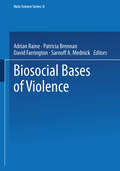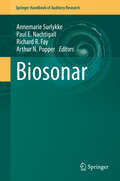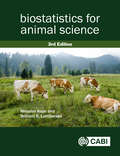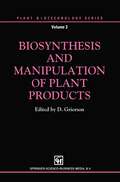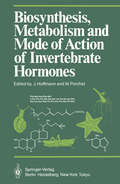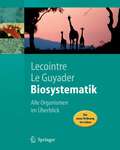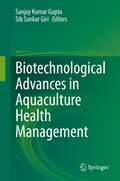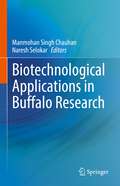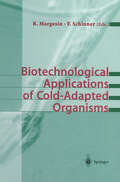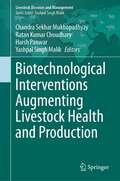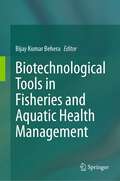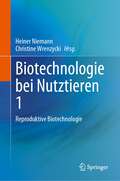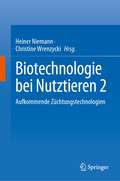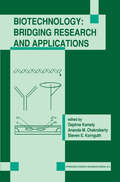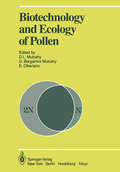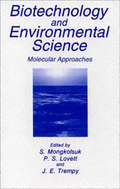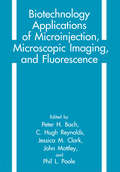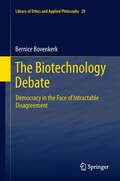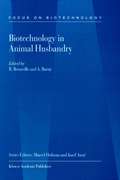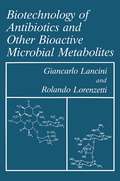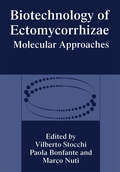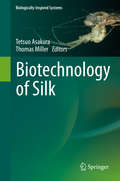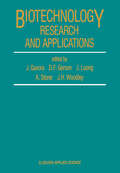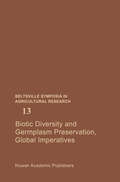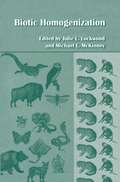- Table View
- List View
Biosocial Bases of Violence (Nato Science Series A: #292)
by Adrian Raine Patricia Brennan David P. Farrington Sarnoff A. MednickProceedings of a NATO ASI held in Rhodes, Greece, May 12-21, 1996
Biosonar (Springer Handbook of Auditory Research #51)
by Annemarie Surlykke Paul E. Nachtigall Richard R. Fay Arthur N. PopperTwo groups of animals, bats and odontocetes (toothed whales), have independently developed the ability to orient and detect prey by biosonar (echolocation). This active mechanism of orientation allows these animals to operate under low light conditions. Biosonar is a conceptual overview of what is known about biosonar in bats and odontocetes. Chapters are written by bat and odontocetes experts, resulting in collaborations that not only examine data on both animals, but also compare and contrast mechanisms. This book provides a unique insight that will help improve our understanding of biosonar in both animal groups.
Biostatistics for Animal Science
by Miroslav Kaps William LambersonDesigned to cover techniques for analysis of data in the animal sciences, this popular textbook provides an overview of the basic principles of statistics enabling the subsequent applications to be carried out with familiarity and understanding. Each chapter begins by introducing a problem with practical questions, followed by a brief theoretical background. Most topics are followed up with numerical examples to illustrate the methods described using data-sets from animal sciences and related fields. The same examples are then solved using the SAS software package. Key features of this third edition: - Updated throughout, and covers a wealth of new distributions and new material on non-normal dependent variables - Improved clarity of text and examples - Includes both basic techniques and more complex procedures to provide an essential resource whatever your level - Contains exercises and many worked examples in SAS. Written primarily for students and researchers in animal sciences, the text is also useful for those studying agricultural, biological, and veterinary sciences.
Biosynthesis and Manipulation of Plant Products (Plant Biotechnology Series)
by Donald GriersonVolumes I and 2 of this Plant Biotechnology series reviewed fundamental aspects of plant molecular biology and discussed production and analysis of the first generation of transgenic plants of potential use in agriculture and horticulture. These included plants resistant to insects, viruses and herbicides, which were produced by adding genes from other organisms. Realisation of the potential of plant breeding has led to a resurgence of interest in methods of altering the structure, composition and function of plant constituents, which represents an even greater challenge and offers scope for improving the quality of a wide range of agricultural products. This, in tum, has resulted in a re-evaluation of priorities and targets by industry. Volume 3 of this series considers the biochemical and gentic basis of the biosynthesis of plant products such as starch, lipids, carotenoids and cell walls, and evaluates the ways in which biosynthesis of these products can be modified for use in the food industries. Authors also cover the biosynthesis of rare secondary products and the function and application of proteins for plant protection and therapeutic use. The emphasis throughout is on the relationship between fundamen tal aspects of biosynthesis and structure-function relationships, and application of this knowledge to the redesigning and altering of plant products by molecular genetics.
Biosynthesis, Metabolism and Mode of Action of Invertebrate Hormones (Proceedings in Life Sciences)
by J. Hoffmann M. PorchetBiosystematik: Alle Organismen Im Überblick (Springer-Lehrbuch)
by Guillaume Lecointre Hervé Le GuyaderWussten Sie, dass Sie mit einem Röhrling näher verwandt sind als mit einem Gänseblümchen oder Vögel den Krokodilen näher sind als Eidechsen? In den letzten 30 Jahren sind die Methoden der Klassifikation des Lebens völlig neu überdacht worden. Das Resultat stellt die bisherige Einteilung der mehr als 2 Millionen bekannten Arten auf den Kopf. Das Buch hilft, die organismische Vielfalt zu bewältigen, indem wesentliche Einteilungs- und Ordnungskriterien vorgestellt und bedeutende stammesgeschichtliche Entwicklungslinien diskutiert werden.
Biotechnological Advances in Aquaculture Health Management
by Sanjay Kumar Gupta Sib Sankar GiriThis book is an inclusive coverage of advances in aquaculture health management. It offers latest updates as well as explains the novel concepts and issues related to aquatic animal health management. To support the understanding of the concepts, there is extensive use of illustrations. Chapters emphasize on the state of art techniques and hold great promise for the sustainable development of aquaculture. This book is of interest to teachers, researchers, aquatic biologists, capacity builders and policymakers. Also the book serves as additional reading material for undergraduate and graduate students of aquatic sciences, marine sciences, biotechnology, ecology, and environmental sciences. National and international aquatic scientists, policy makers will also find this to be a useful read.
Biotechnological Applications in Buffalo Research
by Manmohan Singh Chauhan Naresh SelokarThis book comprehensively reviews the advancements in biotechnological applications for the enhanced production and conservations of buffalo (Bubalus bubalis). The book discusses developments in assisted reproduction to improve productivity and the produce novel products for applications to human health and nutrition. The initial chapters of the book discuss the global distribution and domestications of buffalo, and nutritive values of buffalo milk, while the subsequent sections examine the applications of the genome-wide association traits to identify potential genetic variants affecting important economic traits. It identifies predictive biomarkers for postpartum or peripartum diseased-state and presents potential protein biomarkers for the diagnosis of early pregnancy in buffalo. Lastly, it discusses recent scientific developments such as induced pluripotent stem cells, spermatogonial stem cells, somatic cell nuclear transfer, and buffalo as a model for human biomedical research. This book is a useful source to students, academicians, researchers, and policymakers who are involved in buffalo science and industry.
Biotechnological Applications of Cold-Adapted Organisms
by Rosa Margesin Franz SchinnerHow can industry profit from the biochemical tricks of cold-adapted organisms? This book covers a range of aspects in this fascinating field, from genetic tools to environmental biotechnology.
Biotechnological Interventions Augmenting Livestock Health and Production (Livestock Diseases and Management)
by Chandra Sekhar Mukhopadhyay Ratan Kumar Choudhary Harsh Panwar Yashpal Singh MalikThis book comprehensively discusses the applications of molecular genetics, functional and structural genomics, and proteomics vis-a-vis bioinformatics, artificial intelligence, and robotics in livestock healthfulness and productivity. It reviews the biotechnological approaches in veterinary sciences for increasing productivity and resistance to disease. The book emphasizes the approaches based on artificial intelligence to analyze the data collected on animals, pathogens, and their environment. It underscores artificial intelligence applications in disease diagnosis, epidemiological studies, and detecting biological phenomena, including heat-detection, pregnancy, docility, and infections. Further, the book examines the genomics and proteomics approaches for understanding the gut microbiota and the role of pathogen-host interactions in animal health and disease. Lastly, it explores both pathogenic and non-pathogenic microbial transfer between humans, animals, and the environment across one health spectrum.
Biotechnological Tools in Fisheries and Aquatic Health Management
by Bijay Kumar BeheraThis edited book is focused on SDG 14: life below water. This book covers all aspects of fish biotechnology and health management. A detailed description is provided of CRISPR Cas9 technology application in the development of superior variety of fish with better growth, disease resistance, etc., accompanied by numerous helpful photographs and schematic diagrams. In addition, recent developments in nanotechnology and its application in fisheries production enhancement have been discussed. Further, topics includes, probiotics, immunostimulants, fish genetic markers, bioremediation, metagenomics, transgenerational immune priming, application of cell culture in fisheries and nano-biosensor application on fish disease diagnosis, pollution monitoring, etc. are provided in details. . The book is helpful for researchers, teachers, students, farmers, and entrepreneurs in utilizing the knowledge on recent advancements in different aspects of fish genetics and biotechnology for future research and aquaculture production enhancement.
Biotechnologie bei Nutztieren 1: Reproduktive Biotechnologie
by Heiner Niemann Christine WrenzyckiDieses zweibändige Lehrbuch bietet einen umfassenden Überblick über das weite Feld der Tierbiotechnologie mit besonderem Schwerpunkt auf der Reproduktion und Zucht von Nutztieren. Der Leser wird mit einer Vielzahl modernster Technologien und neuer genetischer Instrumente und deren Anwendungen in der Tierproduktion vertraut gemacht. Außerdem werden ethische und rechtliche Aspekte der Tierbiotechnologie erörtert und neue Trends und Entwicklungen auf diesem Gebiet kritisch bewertet. Das zweibändige Werk ist ein Muss für Doktoranden, fortgeschrittene Studenten und Forscher auf dem Gebiet der Veterinärmedizin, Genetik und Tierbiotechnologie.Dieser erste Band befasst sich hauptsächlich mit künstlicher Befruchtung, Embryotransfertechnologien bei verschiedenen Tierarten und der Kryokonservierung von Eizellen und Embryonen.
Biotechnologie bei Nutztieren 2: Aufkommende Züchtungstechnologien
by Heiner Niemann Christine WrenzyckiDieses zweibändige Lehrbuch bietet einen umfassenden Überblick über das weite Feld der Tierbiotechnologie mit besonderem Schwerpunkt auf der Reproduktion und Zucht von Nutztieren. Der Leser wird mit einer Vielzahl modernster Technologien und neuer genetischer Instrumente und deren Anwendungen in der Tierproduktion vertraut gemacht. Außerdem werden ethische und rechtliche Aspekte der Tierbiotechnologie erörtert und neue Trends und Entwicklungen auf diesem Gebiet kritisch bewertet. Das zweibändige Werk ist ein Muss für Doktoranden, fortgeschrittene Studenten und Forscher auf dem Gebiet der Veterinärmedizin, Genetik und Tierbiotechnologie.Dieser zweite Band ist den genetischen Werkzeugen der Tierbiotechnologie gewidmet, wie dem somatischen Klonen, transgenen Technologien und der Anwendung von Stammzellen in der Tierzucht. Auch ethische und rechtliche Aspekte werden erörtert.
Biotechnology: Proceedings of the U.S.-Israel Research Conference on Advances in Applied Biotechnology Biotechnology June 24–30, 1990; Haifa, Israel
by Daphne Kamely A. M. Chakrabarty Steven E. KornguthBiotechnology is advancing at a rapid pace with numerous applications in medicine, industry, agriculture and environmental remediation. Recognizing this, government, industrial and academic research and development invest ment in biotechnology has expanded rapidly. The past decade has seen the emergence of applications of this technology with a dual-use potential. Mili tary applications focus on four major areas: biomedical technology, such as vaccine development and medical diagnostics; detection of toxins, chemicals and pathogens; material biotechnology; and biological decontamination, in cluding biodegradation and bioremediation. This conference emphasizes the non-medical applications of biotechnol ogy. The first two sessions focus on the synthesis and properties of molecules that may be used in detectors. The traditional approach to detection of chemical and biological agents relied on the development of specific assays or analyses for known agents. Advances in molecular biology have made possible the production of large quantities of toxins which were previously available in minute quantities, and the molecular engineering of toxins and pathogens with specific pharmacologic and physical-chemical properties. In addition to the traditional approaches to detection of specific known compounds, biotechnology now offers generic approaches to detection. Physiological targets, known as receptors, are primary targets for many drugs and toxins. Similarly, pathogens rely on receptors to gain access to cells. These receptors function as sensitive detectors, generating signals which are transduced and amplified.
Biotechnology and Ecology of Pollen: Proceedings of the International Conference on the Biotechnology and Ecology of Pollen, 9–11 July, 1985, University of Massachusetts, Amherst, MA, USA
by David L. Mulcahy Gabriella Bergamini Mulcahy Ercole OttavianoIn Recognition of the Forgotten Generation D. L. MULCAHyl Pollen was long believed to serve primarily a single function, that of delivering male gametes to the egge A secondary and generally overlooked value of pollen is that it serves to block the transmission of many defective alleles and gene combinations into the next generation. This latter function comes about simply because pollen tubes carrying defective haploid genotypes frequently fail to complete growth through the entire length of the style. However, the beneficial consequences of this pollen selection are diluted by the fact that the same deleterious genotypes are often transmitted through the egg at strictly mendelian frequencies (Khush, 1973). Gene expression in the pollen might thus at least appear to be a phenomenon of trivial consequence. Indeed, Heslop-Harrison (1979) rightly termed the gametophytic portion of the angiosperm life cycle, the "forgotten generation." This neglect, however, came about despite subtle but constant indications that pollen is the site of intense gene activity and selection. For example, Mok and Peloquin (1975) demonstrated that relatively heterozygous diploid pollen shows heterotic characteristics whereas relatively homozygous diploid pOllen does not. This was proof positive that genes are expressed (that is, transcribed and translated) in the pollen. 1 Department of Botany, University of Massachusetts Amherst, MA 01003, USA viii However, the implications for pollen biology of even this recent and well known study were not widely recognized.
Biotechnology and Environmental Science: Molecular Approaches
by S Mongkolsuk P. S. Lovett J. E. TrempyBiotechnology Applications of Microinjection, Microscopic Imaging, and Fluorescence
by Peter H. Bach C. H. Reynolds J. M. Clark J. Mottley P. L. PooleIndividual cells behave in surpnsmg ways that cannot be deduced from the averaged results of an organ as assessed by the use of conventional biochemical methods. Thus multicellular plant and animals systems are being investigated by an increasing array of histochemical and cytochemical techniques based on general chemical or specific immunological interactions to identify structural materials and to assess biological activities. In recent years there has been an increasing range of fluorescent probes, along with advanced computerised imaging and analysis techniques, which allows the behaviour of individual living cells to be followed in considerable detail. The parallel use of microinjection, microelectrodes and patch-clamping provides additional information about cells and their responses. Recombinant DNA technology has highlighted the desirability and the power of microinjecting defined materials into specific cells and so manipulating their fundamental biochemistry. New hypotheses are being tested which will form the cornerstone of future developments across the whole spectrum of biotechnology. The First European Workshop on Biotechnology Applications of Microinjection, Microscopic Imaging and Fluorescence was run at the University of East London, U.K, 21st-24th April, 1992 with the objective of bringing together a diverse group of individuals who were using these state-of-the-art applications for biotechnological exploration. A novel feature of the meeting was paiticipation by instrument manufacturers in the programme: there were hands-on workshops (where living cells could be examined), combined with the poster sessions.
The Biotechnology Debate: Democracy in the Face of Intractable Disagreement (Library of Ethics and Applied Philosophy #29)
by Bernice BovenkerkThis book grounds deliberative democratic theory in a more refined understanding of deliberative practice, in particular when dealing with intractable moral disagreement regarding novel technologies. While there is an ongoing, vibrant debate about the theoretical merits of deliberative democracy on the one hand, and more recently, empirical studies of specific deliberative exercises have been carried out, these two discussions fail to speak to one another. Debates about animal and plant biotechnology are examined as a paradigmatic case for intractable disagreement in today’s pluralistic societies. This examination reveals that the disagreements in this debate are multi-faceted and multi-dimensional and can often be traced to fundamental disagreements about values or worldviews. “One of the acute insights to emerge from this examination is that deliberation can serve different purposes vis-à-vis different types of problem. In the case of deeply unstructured problems, like the modern biotechnology debate, the aim of inclusion is more appropriate than the aim of consensus. This book highlights the importance of political culture and broader institutional settings in shaping the capacity and propensity of citizens to engage in deliberation and the degree to which governments are prepared to relinquish authority to deliberative mini-publics."Robyn Eckersley, University of Melbourne, Australia
Biotechnology in Animal Husbandry (Focus on Biotechnology #5)
by R. Renaville A. BurnyAnimal biotechnology is a broad umbrella encompassing the polarities of fundamental and applied research including molecular modelling, molecular and quantitative genetics, gene manipulation, development of diagnostics and vaccines and manipulation of tissue or digestion metabolism by growth promoters. Although animal biotechnology in the broadest sense is not new, what is new is the level of complexity and precision involved in scientists' current ability to manipulate living organisms. This new book sets out to show that the important ideas in animal biotechnology are exciting and relevant to everyday experience. It represents an important update of the literature for research workers, lecturers, and advisers in animal science, but is also a core text for advanced undergraduate courses in animal science and biotechnology. It will be an essential acquisition for librarians in agriculture and veterinary science.
Biotechnology of Antibiotics and Other Bioactive Microbial Metabolites
by G. Lancini R. LorenzettiIn response to the field's need for an introductory text, the authors have distilled the vast and scattered literature relating to the biotechnology of microbial secondary metabolites. General biology, biosynthesis, the search for novel metabolites, and techniques for strain improvement are all discussed to provide undergraduate and graduate students with a concise, readable overview of the field.
Biotechnology of Ectomycorrhizae: Molecular Approaches
by P. Bonfante M. Nuti V. StocchiForty years after the discovery of the helix nature of DNA and more than twenty after the first applications of recombinant DNA technology to the pharmaceutical industry, the Pandora's vase of biotechnology seems far from being empty. New products for agriculture and the food industry are constantly being placed on the market, and powerful monitoring techniques have been developed to track non-modified and genetically modified vaccines, viruses, microbes and plants released into the environment. Molecular approaches for taxonomic purposes, which might also be useful for quality control and assurance, have been successfully developed and used for taxonomic purposes in the last decade for both prokaryotic and eukaryotic cells, including yeasts and filamentous fungi. Mycorrhizae are one example of a traditional biotechnology that can greatly benefit from the latest molecular approaches. These universal symbioses between soil fungi and plant roots playa central role in most of the natural and agricultural ecosystems in such key processes as nutrient cycling, soil structural conservation and plant health. For these reasons, mycorrhizae have been successfully used to improve the quality of forest and agricultural seedlings, to produce high-quality micropropagated plants and to increase the production of edible mushrooms of high economic value, such as truffles. However, although controlled inoculation of oak and hazel seedlings with ectomycorrhizal truffles has been carried out for decades in France and Italy, and is still expanding commercially, several technological gaps remain to be filled.
Biotechnology of Silk (Biologically-Inspired Systems #5)
by Tetsuo Asakura Thomas MillerThis book is a snapshot of the current state of the art of research and development on the properties and characteristics of silk and their use in medicine and industry. The field encompasses backyard silk production from ancient time to industrial methods in the modern era and includes an example of efforts to maintain silk production on Madagascar. Once revered as worth its weight in gold, silk has captured the imagination from its mythical origins onwards. The latest methods in molecular biology have opened new descriptions of the underlying properties of silk. Advances in technological innovation have created silk production by microbes as the latest breakthrough in the saga of silk research and development. The application of silk to biomaterials is now very active on the basis of excellent properties of silks including recombinant silks for biomaterials and the accumulated structural information.
Biotechnology Research and Applications
by J. Gavora D. F. Gerson J. Luong A. Storer J. H. WoodleyHistorically, ruminant animals have provided farmers with the ability to utilize marginal lands for the production of high quality food for human consumption. Ruminants are able to derive their nourishment from feeds that are not in themselves capable of meeting the nutritional needs of the animal. They do this by supporting in the rumen, which is a greatly enlarged region of the stomach which precedes the animals digestive system, a microbial fermentation system. This system partially degrades complex polysaccharides and provides to the animal not only the degradation products (chiefly volatile fatty acids), but also secondary microbial metabolites and microbial biomass (most importantly microbial protein, which can be synthetized from inorganic nitrogen sources). A ruminant animal is able to survive, if not thrive, on a diet containing only cellulose, a non-protein nitrogen source such as urea, and trace minerals. The capacity of the rumen to process low quality feeds is limited by factors such as rumen volume, the time required for digestion of these feeds in the rumen, and the ability of the animal to chew the feed. Hodern ruminant animals have been intensively selected for high production potential, but the limited capacity of the rumen fermentation means that this potential cannot be realized by feeding the animal low quality feeds. The high production potential of these animals can only be realized by feeding large amounts of readily digestible, high quality feeds such as oilseed meals and grains.
Biotic Diversity and Germplasm Preservation, Global Imperatives (Beltsville Symposia in Agricultural Research #13)
by Lloyd Knutson Allan K. StonerTopics for the Beltsville Symposia are selected to highlight specific areas of research and science policy that are of concern to scientists in the Beltsville Area as well as to the general scientific community. Each sympo sium in the series is structured to provide a realistic appraisal of current findings, research progress, and relevant policy issues within the constraints established by the organizing committee. Thus, the presentations and dis cussions that have marked these symposia have had a strong appeal to the broad community of scientists. Knowledge of the diversity of living organisms is still quite limited. Since the time of Linnaeus, about 1.7 million species have been described. The actual number has been estimated between 5-50 million. Many species, land races, and strains are vanishing. Clearly, the world's scientific institutions are inadequately equipped to attain sufficient knowledge of a significant fraction of the diverse living forms. Also, efforts in the collection and preservation of germplasm of plants and animals urgently need to be strengthened. These mattes are critically important to future generations. This symposium addresses vital concerns of biotic diversity and germ plasm preservation from diverse perspectives. Many of the parts provide concrete recommendations for action, and they call attention to areas of research that must be pursued with intensity.
Biotic Homogenization
by Michael L. McKinney Julie L. LockwoodBiological homogenization is the dominant process shaping the future global biosphere. As global transportation becomes faster and more frequent, it is inevitable that biotic intermixing will increase. Unique local biotas will become extinct only to be replaced by already widespread biotas that can tolerate human activities. This process is affecting all aspects of our world: language, economies, and ecosystems alike. The ultimate outcome is the loss of uniqueness and the growth of uniformity. In this way, fast food restaurants exist in Moscow and Java Sparrows breed on Hawaii. Biological homogenization qualifies as a global environmental catastrophe. The Earth has never witnessed such a broad and complete reorganization of species distributions.
